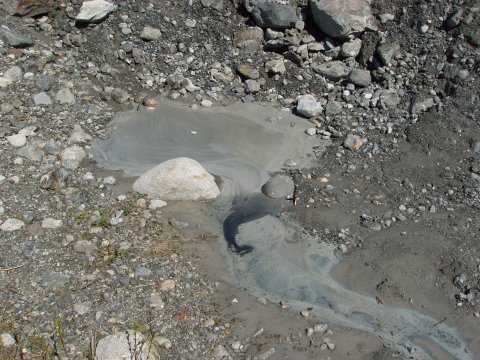|
It's hard job to grow a mastiff from a mud puddle...

If you have not read the "What is Life?" page recently you might want to review it before taking on this one. On that page I raised several possibilities for the origins of the one-celled creatures called prokaryote from which it is supposed that all plant and animal life evolved. Living creatures are entities that participate in the following list of activities.
•Maintaining its boundaries.
•Movement.
•Responding to stimuli.
•Ingestion.
•Metabolism.
•Excretion.
•Reproduction
•Growth
•Exhibiting homeostasis
•Evolving

Consider the proposition that the first living entity evolved from something simpler. Beginning with the sub atomic particles: protons, neutrons and electrons, we find that when brought close enough together by gravity they spontaneously assemble themselves into the atoms that we find in nature. Might not this sort of self assembly extend to animate matter? The key to the self assembly of atoms is that the assembled atom represents a lower energy configuration than its separated constituents. Because inanimate things tend to seek their lowest available energy configuration, like a ball rolling down hill, atoms are much more likely to be found on Earth than are the isolated protons, neutrons and electrons. The assembly of atoms into inorganic molecules follows the same principle. A water molecule consisting of one oxygen and two hydrogen atoms (H2O) is a lower energy configuration then the atoms existing separately. In assembling a water molecule, the energy decrease in the assembled molecule is released to the environment in the form of heat. Molecules that give up a lot of energy in their formation are very stable, meaning they are not easily disassembled.
Living things require very complex structures, called organic molecules, in addition to water. As far as I know, the creation of organic molecules from inorganic ones always requires an initial addition of energy, rather than having energy given up in their formation. It is a bit like rolling a ball up a hill into a little depression at the top. The ball will stay there but it doesn't take much of a push to get it over the lip of the depression and from there it rolls down the hill destroying the top of the hill configuration. Organic molecules come apart easily and thereafter their constituents may combine with other elements, like oxygen, to release a lot of energy. That is how we may take leftover organic molecules from formerly living organisms and with the addition of just a little heat, get lots of heat out of them. Coal, oil and dry wood are examples of this process. The assembly of some of the simpler organic molecules from inorganic ones has been achieved in laboratories. To date the laboratory attempts to combine these organic molecules into a living cell has not succeeded but we cannot take that to mean that Nature's laboratory could not make it happen. Even Nature though faces some significant hurdles in covering the gap from simple organic molecules to living things.
Living objects are even less stable than the separate organic molecules. They require a constant supply of energy to maintain their state of being alive. In the ball on a hill analogy, the ball now must be kept on top of the depressionless hill by constantly poking at it as it starts to roll down. The two items, ingestion and metabolism, from the list of life activities are the means of supplying a constant energy input to living objects. One of nature's laws is that no irreversible process, like metabolism, can be 100% efficient so metabolism leaves waste products that must be eliminated for life to continue, making excretion one of life's required activities. In order for ingestion, metabolism and excretion to work there must be a clear distinction between the inside and outside of a living object. If the environment could mix indiscriminately with the parts of a cell, the cell would soon be diluted out of existence. Even in the presence of a well maintained boundary, the cell still needs to maintain, within the boundary, the conditions necessary for ingestion, metabolism and excretion to be carried out. This is the homeostasis life activity. If the cell could not reproduce it would be the only instance and the lifeform would be extinguished with the first environmental accident. Of course reproduction by simple cell division requires subsequent growth because halves are smaller than wholes. There are also advantages in sexual reproduction of having offspring begin life smaller than full grown adults.
If an organism were living in an environment in which a constant stream of food were supplied and waste products were removed, perhaps it could get by with just the 7 out of 10 life activities identified in the above paragraph. In the real world there are not many environments as accommodating as suggested here, possibly none at all. Even single cell organisms have to move to find food, escape becoming food themselves and escape environmental threats. To "decide" which way to move, the cell must be able to respond to environmental stimuli. Because the environment itself is unstable, gradually changing over time, all the living objects we find on Earth have the ability to evolve. The evolution process is grossly inefficient, producing negligible or harmful mutations much more often than beneficial ones, but clearly no evolution at all is even worse. If that were not the case, we should be able to find successful non-evolving lifeforms.
Let's consider the theory of evolution as applied to living organisms. The story goes that lifeforms undergo changes due to mutations, basically damage to the DNA that one generation passes on to the next. The damaged genetic material means that the offspring are genetically different from the parent or parents. Because there are a lot more ways for things to go wrong then there are for things to go right, most of these bad-copy offspring fail to survive to reproduce. Rarely however the change helps the offspring be more successful at handling the stress of the environment than their parents and if they reproduce successfully, eventually the mutated individuals displace the original population because of their competitive advantage. The key to this process is natural selection, sometimes expressed as the survival of the fittest. It only works if there is stress driving the process. By stress in this context I mean something that prevents the less fit from reproducing in adequate numbers to sustain the population. Among modern lifeforms there is competition for space, food and mates. There is also stress from predators and environmental changes.
How are we to apply this notion of evolution to the raising of a living organism from a clearly non-living aggregation of molecules? As such they had no need of food or mates and their need for space would be minimal since they did not need hunting territory. There would be no predation against them since there were no living organisms out looking for food. There were likely to be dramatic changes in the environment in the turbulent early days of the planet but dramatic changes are not beneficial to evolution. Wild swings in environmental conditions are apt to break up complicated barely stable aggregations of marginally stable molecules.
In addition to the absence of appropriate evolutionary stress on non-living collections of molecules, we have another problem. All living entities include some form of DNA or RNA, which contains the instructions for how all this assembly of organic compounds is to be organized in order to carry out the life defining activities. They also includes proteins which require the information in the DNA so they may be synthesized from the simpler amino acids. The DNA itself is based on a polymer which requires certain proteins. That puts us into the "Which came first, the chicken or the egg?" situation. DNA is required to make proteins and proteins are required to make DNA.
In consideration of all the above, it seems to me that the chasm between non-living and living matter is wide and deep. Evolution makes small changes in living objects over a long time but the change from non-living to living looks like it has to happen all at once in order for the result to be a viable lifeform. This may be a true case of irreducible complexity, which has been suggested in connection with gaps in the theory of evolution. Critics of this notion call it an argument from ignorance, which is perhaps valid. In the absence of ignorance we would not have to propose any theories at all. Be that as it may, irreducible complexity implies that there is no path from the first state to the second that can be explained by evolution alone. The transition to living from non-living matter seems to me to be such a situation. Any move toward life from non-life has to go all the way, otherwise the result is just another non-living aggregation of atoms. I think we need to look at possibilities other than some sort of gradual buildup from inorganic material, guided either by evolution or chance. There has been another theory put forward to explain the origin of life on earth, that life came from space, riding meteorites. That may be true but it does not solve the first-life riddle. It simply moves the riddle to another venue.
On the next page we will fall back a bit and consider inanimate matter, not quite so well behaved, to illustrate one of the most powerful concepts in modern science, that of an attractor.
|




